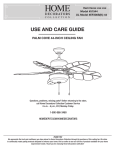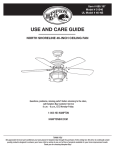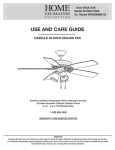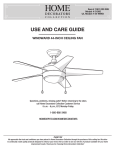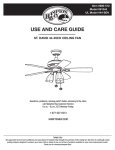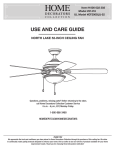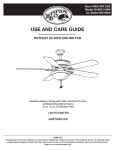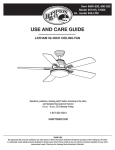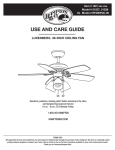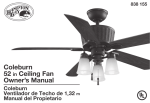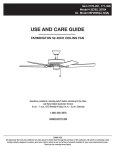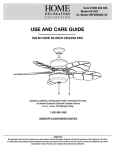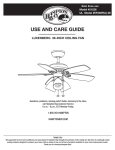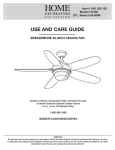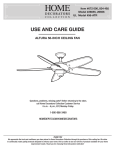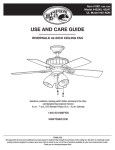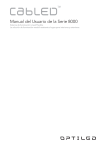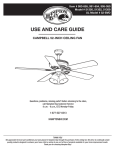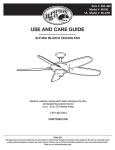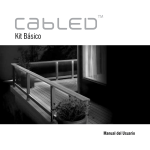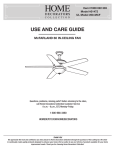Download Hampton Bay 51548 Instructions / Assembly
Transcript
Item #685 196 Model #51548 UL Model #EF200S(P)-48 USE AND CARE GUIDE TUCSON 48-INCH CEILING FAN Questions, problems, missing parts? Before returning to the store, call Hampton Bay Customer Service 8 a.m. - 6 p.m., EST, Monday-Friday. 1-855-HD-HAMPTON HAMPTONBAY.COM THANK YOU We appreciate the trust and confidence you have placed in Hampton Bay through the purchase of this ceiling fan. We strive to continually create quality products designed to enhance your home. Visit us online to see our full line of products available for your home improvement needs. Thank you for choosing Hampton Bay! Table of Contents Table of Contents................................................................. 2 Assembly............................................................................... 7 Safety Information................................................................ 2 Operation............................................................................ 13 Warranty................................................................................ 3 Care and Cleaning.............................................................. 14 Pre-Installation..................................................................... 3 Troubleshooting.................................................................. 14 Installation............................................................................. 6 Safety Information 1. All wiring must be in accordance with the National Electrical Code ANSI/NFPA 70 and local electrical codes. Electrical installation should be performed by a qualified licensed electrician. WARNING: To reduce the risk of personal injury, do not bend the blade brackets (also referred to as flanges) during assembly or after installation. Do not insert objects in the path of the blades. 2. The outlet box and support structure must be securely mounted and capable of reliably supporting 35 lbs. (15.9 kg). Use only UL Listed outlet boxes marked “Acceptable for Fan Support of 35 lbs. (15.9 kg) or less.” WARNING: Remove the rubber motor stops on the bottom of the fan before installing the blades or testing the motor. 3. The fan must be mounted with a minimum of 7 ft (2.1 m) clearance from the trailing edge of the blades to the floor. WARNING: To reduce the risk of fire or electric shock, do not use this fan with any solid-state speed control device. 4. Do not operate the reversing switch while the fan blades are in motion. You must turn the fan off and stop the blades before you reverse the blade direction. WARNING: To reduce the risk of fire, electric shock or personal injury, mount to outlet box marked “acceptable for fan support of 35 lbs. (15.9 kg) or less” and use screws provided with the outlet box. 5. Do not place objects in the path of the blades. 6. Electrical diagrams are for reference only. Light kits that are not packed with the fan must be UL listed and marked suitable for use with the model fan you are installing. Switches must be UL General Use Switches. Refer to the instructions packaged with the light kits and switches for proper assembly. Use 14W CFL bulbs max (included). WARNING: To avoid possible electrical shock, turn the electricity off at the main fuse box before wiring. If you feel you do not have enough electrical wiring knowledge or experience, contact a licensed electrician. 7. After making electrical connections, spliced conductors should be turned upward and pushed carefully up into the outlet box. The wires should be spread apart with the grounded conductor and the equipment-grounding conductor on one side of the outlet box. CAUTION: To reduce the risk of personal injury, use only the screws provided with the outlet box. CAUTION: To avoid personal injury or damage to the fan and other items, use caution when working around or cleaning the fan. 8. All setscrews must be checked and retightened where necessary before installation. 9. Suitable for use in wet locations when installed in a GFCI protected branch circuit. Use only with light kits marked “Suitable for use in wet locations”. 2 Warranty The supplier warrants the fan motor to be free from defects in workmanship and material present at time of shipment from the factory for a lifetime after the date of purchase by the original purchaser. The supplier also warrants that all other fan parts, excluding any glass or acrylic blades, to be free from defects in workmanship and material at the time of shipment from the factory for a period of one year after the date of purchase by the original purchaser. We agree to correct such defects without charge or at our option replace with a comparable or superior model if the product is returned. To obtain warranty service, you must present a copy of the receipt as proof of purchase. All costs of removing and reinstalling the product are your responsibility. Damage to any part such as by accident or misuse or improper installation or by affixing any accessories, is not covered by this warranty. Because of varying climatic conditions this warranty does not cover any changes in brass finish, including rusting, pitting, corroding, tarnishing, or peeling. Brass finishes of this type give their longest useful life when protected from varying weather conditions. A certain amount of “wobble” is normal and should not be considered a defect. Servicing performed by unauthorized persons shall render the warranty invalid. There is no other express warranty. Hampton Bay hereby disclaims any and all warranties, including but not limited to those of merchantability and fitness for a particular purpose to the extent permitted by law. The duration of any implied warranty which cannot be disclaimed is limited to the time period as specified in the express warranty. Some states do not allow a limitation on how long an implied warranty lasts, so the above limitation may not apply to you. The retailer shall not be liable for incidental, consequential, or special damages arising out of or in connection with product use or performance except as may otherwise be accorded by law. Some states do not allow the exclusion of incidental or consequential damages, so the above exclusion or limitation may not apply to you. This warranty gives specific legal rights, and you may also have other rights which vary from state to state. This warranty supersedes all prior warranties. Shipping costs for any return of product as part of a claim on the warranty must be paid by the customer. Contact the Customer Service Team at 1-855-HD-HAMPTON or visit www.HamptonBay.com. Pre-Installation SPECIFICATIONS Size Speed Volts Low 48 in. Medium 120 High Amps Watts RPM CFM 0.22 10 73 2050 0.38 29 126 3424 0.5 60 184 4719 Net Weight Gross Weight Cube Feet 16.76 lbs. (7.6 kg) 18.74 lbs. (8.5 kg) 1.61 cu.ft. NOTE: These are approximate measures. They do not include the Amps and Wattage used by the light kit. TOOLS REQUIRED Phillips screwdriver Flat blade screwdriver Adjustable wrench Electrical tape Wire cutter Step ladder 3 HAMPTONBAY.COM Please contact 1-855-HD-HAMPTON for further assistance. Pre-Installation (continued) HARDWARE INCLUDED NOTE: Hardware not shown to actual size. AA BB DD CC EE Part Description Quantity AA Rubber Gasket 1 BB Pull Chain 2 CC Plastic Wire Connector 3 Part 4 Description Quantity DD Hanging Pin 1 EE Locking Pin 1 Pre-Installation (continued) PACKAGE CONTENTS A J G B H C D I E K F Part Description Quantity A Slide-on mounting bracket (inside canopy) 1 B Ball/downrod assembly C Part Description Quantity F Fan-motor assembly 1 G Light kit fitter assembly 1 1 H Shatter resistant shade 3 Canopy 1 I Blade bracket 5 D Canopy ring 1 J Blade 5 E Coupler cover 1 K CFL bulb, 14-watts maximum 3 IMPORTANT: This product and/or components are governed by one or more of the following U.S. Patents: 5,947,436; 5,988,580; 6,010,110; 6,046,416, 6,210,117 and other patents pending. 5 HAMPTONBAY.COM Please contact 1-855-HD-HAMPTON for further assistance. Installation MOUNTING OPTIONS WARNING: To reduce the risk of fire, electric shock or personal injury, mount to outlet box marked “Acceptable for fan support of 35 lbs. (15.9 Kg) or less”, and use screws provided with the outlet box. An outlet box commonly used for the support of lighting fixtures may not be acceptable for fan support and may need to be replaced. If in doubt, consult a qualified electrician. NOTE: You may need a longer downrod to maintain proper blade clearance when installing on a steep, sloped ceiling. The maximum angle allowable is 30° away from horizontal. Hanger Bar If your ceiling fan does not have an existing UL-listed mounting box, then install one using the following instructions: □□ Disconnect the power by removing the fuses or turning off the circuit breakers. □□ Secure the outlet box directly to the building structure. Use Outlet Box the appropriate fasteners and materials. The outlet box and its bracing must be able to fully support the weight of the moving fan (at least 35 lbs.). Do not use a plastic outlet box. The illustrations below show three different ways to mount the outlet box. If the canopy touches the downrod, then remove the canopy bottom cover, and turn the canopy 180° before attaching the canopy to the mounting plate. To hang your fan where there is an existing fixture but no ceiling joist, you may need an installation hanger bar as shown above (available at any Home Depot store). Outlet Box Outlet Box Provide Strong Support Recessed Outlet Box Ceiling Mounting Plate 6 Assembly - Standard Ceiling Mount 1 2 Preparing for mounting □□ Remove the canopy ring (D) from the canopy (C) by turning □□ □□ Routing the wires □□ Route the wires exiting the top of the fan motor (F) through the coupler cover (E), and canopy ring (D). the ring counterclockwise until it unlocks. Remove the mounting bracket (A) from the canopy (C) by loosening the two canopy screws (FF) located in the “L shaped” slots. Remove and save the two canopy screws (FF) and lock washers (GG) in the round holes. This will enable you to remove the mounting bracket (A). □□ Make sure the slot openings are on top and route the wires through the canopy (C) and then through the ball/downrod assembly (B). C D A E B GG FF C D F 3 Assembling the fan WARNING: Failure to properly install the locking pin could result in the fan becoming loose and possibly falling. □□ Loosen, but do not remove, the two setscrews (HH) on the □□ □□ □□ □□ EE collar (II) on top of the motor housing. Align the holes at the bottom of the downrod (B) with the holes in the collar (II) on top of the motor housing. Carefully insert the hanger pin (DD) through the holes in the collar (II) and downrod (B). Be careful not to jam the hanger pin (DD) against the wiring inside the downrod (B). Insert the locking pin (EE) through the hole near the end of the hanger pin (DD) until it snaps into its locked position. Re-tighten the two setscrews (HH) on the collar (II) on top of the motor housing. B DD HH 7 II HAMPTONBAY.COM Please contact 1-855-HD-HAMPTON for further assistance. Assembly - Close-To-Ceiling Mount 1 2 Close-to-Ceiling Mounting □□ Remove the canopy ring (D) from the canopy (C) by turning the □□ □□ □□ Routing the wires □□ Remove three of the six screws (JJ) and lock washers (KK) ring counterclockwise until it unlocks. Remove the mounting bracket (A) from the canopy (C) by loosening the two canopy screws (FF) located in the “L shaped” slots. Remove and save the two canopy screws (FF) in the round holes. This will enable you to remove the mounting bracket (A). Remove the decorative canopy bottom cover (L) from the canppy (C) by pressing the three studs. □□ □□ (every other one) securing the motor collar to the top of the fan motor housing (F). Place the rubber gasket (AA) over the remaining three screws and route the wires exiting the top of the fan motor (F) through the canopy ring (D). Make sure the slot opening is on top, then proceed to place the ceiling canopy (C) over the collar at the top of the motor (F). Align the mounting holes with the holes in the motor (F) and fasten, using the three screws (JJ) and lock washers (KK) removed previously. Tighten the screws securely. A JJ KK C GG FF C D AA L F Assembly - Hanging the Fan 1 Attaching the fan to the electrical box WARNING: To reduce the risk of fire, electric shock or personal injury, mount to outlet box marked “Acceptable for fan support of 35 lbs. (15.9 Kg) or less”, and use screws provided with the outlet box. □□ Pass the 120-Volt supply wires through the center hole in the LL LL mounting bracket (A). □□ Install the ceiling mounting bracket on the outlet box by sliding □□ the mounting bracket (A) over the two screws (LL) provided with the outlet box. If necessary, use leveling washers (not included) between the mounting bracket (A) and the outlet box. Note that the flat side of the mounting bracket (A) is toward the outlet box. When using close-to-ceiling mounting, it is important that the mounting bracket be level. Securely tighten the two mounting screws (LL). A 8 Assembly - Hanging the Fan (continued) 2 3 Hanging the fan WARNING: The hook (OO) is only to balance the fan while making the electrical connections. Failure to hang as shown may result in the hook (OO) breaking, causing the fan to fall. The hook must pass from the inside to the outside of the canopy. WARNING: Each wire not supplied with this fan is designed to accept up to one 12-gauge house wire and two wires from the fan. If you have larger than 12-gauge house wiring or more than one house wire to connect to the fan wiring, consult an electrician for the proper size wire nuts to use. WARNING: When hanging the fan on the hook (OO) it is critical that you use one of the non-slotted (round) holes in the canopy (C). WARNING: Remove the rubber motor stops on the bottom of the fan before installing the blades or testing the motor. □□ Carefully lift the fan-motor assembly (F) up to the slide-on IMPORTANT: Use the plastic wire connectors (CC) supplied with your fan. Secure the connectors with electrical tape and ensure there are no loose strands or connections. mounting bracket (A). □□ Insert the ball portion of the ball/downrod assembly into the socket of the slide-on mounting bracket. NOTE: The fan comes with 54 in. lead wires for use with an extended ball/downrod assembly. If using the 4.5 in. ball/downrod assembly (B) provided, you can cut the lead wires to your desired length (no shorter than 12 in.). □□ Turn the ball/downrod assembly clockwise until it is seated □□ Making the electrical connection with the tab of the slide-on mounting bracket aligned with the slot in the ball. If using close-to-ceiling mounting, hang the fan on the hook provided by utilizing one of the round holes at the outer rim of the ceiling canopy (C). □□ The fan comes with 54 in. lead wires for use with an extended Standard mount. □□ A □□ B □□ □□ □□ C F ball/downrod assembly. If using the 4.5 in. ball/downrod assembly (B) provided, you can cut the lead wires to your desired length (no shorter than 12 in.) This will make extra room in the canopy (C), if you do not wish to cut the wires, you will need to neatly wrap them. Connect the fan motor green wires to the household green or bare wire using a wire connecting nut (CC). Connect the fan motor white wire to the household white wire using a wire connecting nut (CC). Connect the fan motor black and blue wires to the household black wire using a wire connecting nut (CC). Secure each wire connecting nut using electrical tape. Turn the wire connecting nut (CC) upward and push the wiring into the outlet box (MM). Black Outlet box in the ceiling MM Green or Bare White Blue & Black White Close to ceiling mount. Green A OO C F 9 HAMPTONBAY.COM Please contact 1-855-HD-HAMPTON for further assistance. Assembly - Hanging the Fan (continued) 4 5 Wrapping the extra wire Mounting the fan-motor assembly (standard mount) WARNING: When using the standard ball/downrod mounting, the tab in the ring at the bottom of the mounting bracket must rest in the groove of the hanger ball. Failure to properly seat the tab in the groove could cause damage to the wiring. NOTE: Follow this step ONLY if you did not cut the extra length off from the wires coming from the ceiling fan. □□ Gently wrap the excess wire around the mounting bracket. □□ Secure with electrical tape. WARNING: The locking slots of ceiling canopy are provided only as an aid to mounting. Do not leave the fan assembly unattended until all four canopy screws are engaged and firmly tightened. □□ Align the locking slots of the ceiling canopy (C) with the two □□ □□ screws in the mounting bracket (A). Push up to engage the slots and turn clockwise to lock in place. Firmly tighten the two mounting screws. Install the two mounting screws (FF) and lock washers (GG) (saved from Assembly Step 1 “Prepairing for mounting”) into the holes in the canopy (C) and tighten firmly. A GG D C F 10 FF Assembly - Hanging the Fan (continued) 6 Mounting the fan-motor assembly (close-to-ceiling mount) A WARNING: The locking slots of ceiling canopy are provided only as an aid to mounting. Do not leave the fan assembly unattended until all four canopy screws are engaged and firmly tightened. GG FF □□ Carefully unhook the fan from the mounting bracket (A) and □□ □□ D align the locking slots of the ceiling canopy (C) with the two screws in the mounting bracket (A). Push up to engage the slots and turn clockwise to lock in place. Immediately tighten the two mounting screws firmly. Install the two mounting screws (FF) and lock washers (GG) (saved from Assembly Step 1 “Prepairing for mounting” into the holes in the canopy (C) and tighten firmly. You may now proceed to attaching the fan blades. C F Assembly - Attaching the Fan Blades 1 Attaching the blade brackets □□ Fasten the blade bracket (I) to the motor (F) by inserting the □□ alignment post into the slot on the bottom of the fan-motor assembly (F) and tightening the motor screws that are preassembled to the blade bracket (I). Repeat for the remaining four blade brackets (I). F I 11 HAMPTONBAY.COM Please contact 1-855-HD-HAMPTON for further assistance. Assembly - Attaching the Fan Blades 2 Attaching the fan blades NOTE: Your fan features revolutionary advancements for quick and easy blade installation. F □□ Mount the fan blades (J) to the blade bracket (I) by aligning □□ □□ □□ □□ □□ the three key-slot holes in the blade (J) with the three posts on the top of the blade brackets (I). Hold the blade (J) close to the blade bracket (I) and press the blade (J) down firmly. Ensure the key-slot holes are properly seated on the blade arm posts. While still holding the blade (J) down, firmly slide the blade (J) away from the bracket (I) side until the blade (J) engages in the locking mechanism (TT). Make sure the locking mechanism (TT) at the rear of the blade bracket (I) springs upward and butts against the edge of the blade (J) indicating a secure connection. Visually inspect the top of the blade bracket (I) to ensure the locking mechanism (TT) is securely in place. Repeat for the remaining blades (J). TT I J Assembly - Attaching the Light Kit 1 Attaching the light kit WARNING: To reduce the risk of electric shock, disconnect the electrical supply circuit to the fan before installing the light kit. □□ Remove the three screws (UU) from the light kit fitter assembly (G). F □□ Connect the wires exiting the bottom of the motor assembly □□ (F) by connecting the molded adaptor plugs together (blue to blue, and white to white). Slide the light kit (G) and secure it to the switch housing using the three screws (UU) that were removed in the first step. G 12 UU Assembly - Attaching the Light Kit 2 Installing the bulbs and attaching the glass bowl CAUTION: Make sure the power is off before attaching or removing the glass shade. CAUTION: Over lamping the fan will result in the fan lights shutting down until the proper wattage bulbs are installed. Reset the lights by turning off the power, replacing the bulbs with the correct wattage bulbs, and turn the power on. F WARNING: Allow the bulb to cool completely before removing. G □□ Twist the shatter resistant shade (H) into light kit fitter (G) H clockwise. □□ Install the bulbs (K) into the sockets on the light kit fitter □□ (G). Attach the pull chain extensions (BB). K BB Operation Turn on the power and check the operation of the fan. The pull chain controls the fan speeds as follows: 1 pull - High, 2 pulls - Medium, 3 pulls - Low, 4 pulls - off A. Warm weather The appropriate speed settings for warm or cool weather depends on factors such as the room size, ceiling height, and number of fans. The slide switch (XX) controls the direction of the blades: Forward (switch down) or Reverse (switch up). XX NOTE: Wait for the fan to stop before reversing the direction of blade rotation. A. Warm weather - (Forward) A downward airflow creates a cooling effect. This allows you to set your air conditioner on a warmer setting without affecting your comfort. B. Cool weather B. Cool weather - (Reverse) An upward airflow moves warm air off of the ceiling. This allows you to set your heating unit on a cooler setting without affecting your comfort. XX 13 HAMPTONBAY.COM Please contact 1-855-HD-HAMPTON for further assistance. Care and Cleaning WARNING: Make sure the power is off before cleaning your fan. □□ Because of the fan’s natural movement, some connections may become loose. Check the support connections, brackets, and blade attachments twice a year. Make sure they are secure. It is not necessary to remove the fan from the ceiling. □□ Clean your fan periodically to help maintain its new appearance over the years. Do not use water when cleaning, as this could damage □□ □□ the motor, or the wood, or possibly cause an electrical shock. Use only a soft brush or lint-free cloth to avoid scratching the finish. The plating is sealed with a lacquer to minimize discoloration or tarnishing. You can apply a light coat of furniture polish to the wood for additional protection and enhanced beauty. Cover small scratches with a light application of shoe polish. You do not need to oil your fan. The motor has permanently-lubricated sealed ball bearings. Troubleshooting Problem Solution The fan will not start. □□ Check the main and branch circuit fuses or breakers. □□ Check the line wire connections to the fan and switch wire connections in the switch housing. The fan is noisy. □□ □□ □□ □□ □□ The fan wobbles. □□ Check that all blade and blade arm screws are secure. □□ Most fan wobble problems are caused when blade levels are unequal. Check this level by selecting a point on the ceiling above the tip of one of the blades. Measure from a point on the center of each blade to the point on the ceiling. Measure this distance. Rotate the fan until the next blade is positioned for measurement. Repeat for each blade. Any measurement deviation should be within 1/8 in. Run the fan for ten minutes. If the fan continues to wobble please contact Customer Service and a balancing kit will be sent to you at no charge. Ensure all motor housing screws are snug. Ensure the screws that attach the fan blade bracket to the motor hub are tight. Ensure the wire nut connections are not rattling against each other or the interior wall of the switch housing. Allow a 24-hour “breaking in” period. Most noises associated with a new fan disappear during this time. If you are using the Ceiling Fan light kit, ensure the screws securing the glassware are tight. Check that the light bulbs are also secure. □□ Ensure the canopy is a short distance from the ceiling. It should not touch the ceiling. □□ Ensure your outlet box is secure and rubber isolator pads were used between the mounting plate and outlet box. 14 Questions, problems, missing parts? Before returning to the store, call Hampton Bay Customer Service 8 a.m. - 6 p.m., EST, Monday-Friday 1-855-HD-HAMPTON HAMPTONBAY.COM Retain this manual for future use. Artículo núm.685 196 Modelo núm.51548 Modelo núm. E F200S(P)-48 aprobado por UL GUÍA DE USO Y MANTENIMIENTO VENTILADOR DE TECHO TUCSON DE 1.22 M ¿Preguntas, problemas o piezas faltantes? Antes de regresar a la tienda, llama al servicio al cliente de Hampton Bay, de lunes a viernes entre 8 a.m. y 6 p.m., (hora estándar del Este) 1-855-HD-HAMPTON HAMPTONBAY.COM GRACIAS POR TU COMPRA Apreciamos la confianza que has depositado en Hampton Bay al comprar este ventilador de techo. Nos esforzamos para continuamente crear productos de calidad diseñados para mejorar tu hogar. Visítanos por Internet para ver nuestra línea completa de productos disponibles para las necesidades de mejoras de tu hogar. ¡Gracias por elegir Hampton Bay! Tabla de contenido Tabla de contenido............................................................... 2 Ensamblaje............................................................................ 7 Información de seguridad................................................... 2 Funcionamiento.................................................................. 13 Garantía................................................................................. 3 Mantenimiento y limpieza.................................................. 14 Preinstalación....................................................................... 3 Solución de problemas...................................................... 14 Instalación............................................................................. 6 Información de seguridad 1. Todo el cableado debe cumplir con el Código Nacional de Electricidad ANSI/NFPA 70 y con los códigos locales de electricidad. La instalación eléctrica debe ser realizada por un profesional calificado y con licencia. ADVERTENCIA: Para reducir el riesgo de lesiones personales, no dobles los soportes de las aspas (también llamados “bridas”) durante el ensamblaje o después de este. No coloques objetos en la trayectoria de las aspas. 2. La caja eléctrica y estructura de soporte deben montarse de forma segura y tener capacidad para sostener de manera confiable 15.9 kg. Usa solamente cajas eléctricas aprobadas por UL marcadas como “apropiada para sostener ventiladores de 15.9 kg o menos”. ADVERTENCIA: Quita los tapones de goma del motor que están en la parte inferior del ventilador antes de instalar las aspas o probar el motor. 3. El ventilador debe ir montado con un mínimo de 2.1 m de separación entre el borde trasero de las aspas y el piso. ADVERTENCIA: Para disminuir el riesgo de incendio o descarga eléctrica, no utilices este ventilador con ningún dispositivo de control de velocidad de estado sólido. 4. No muevas el interruptor de reversa mientras las aspas del ventilador estén en movimiento. Debes apagar el ventilador y esperar que se detengan las aspas antes de dar reversa a la dirección de las aspas. ADVERTENCIA: Para reducir el riesgo de incendio, descarga eléctrica o lesiones personales, instala solo en una caja eléctrica clasificada como “apropiada para sostener ventiladores de 15.9 kg o menos” y usa los tornillos que vienen con esta. 5. No coloques objetos en la trayectoria de las aspas. ADVERTENCIA: Para evitar una posible descarga eléctrica, corta la energía eléctrica en la caja principal de fusibles antes de instalar el cableado. Si crees que no tienes suficiente experiencia o conocimientos sobre cableado eléctrico, contrata a un electricista certificado. 6. Los diagramas eléctricos son solo para referencia. Los kits de luces no incluidos con el ventilador deben estar aprobados por UL y marcados como apropiados para ser usados con el modelo de ventilador a instalar. Los interruptores deberán estar clasificados por UL como de uso general. Consulta las instrucciones adjuntas a los kits de luces e interruptores para obtener información sobre el ensamblaje adecuado. Usa bombillas CFL de un máximo de 14 W (incluidas). PRECAUCIÓN: Para reducir el riesgo de lesiones personales, usa solamente los tornillos incluidos con la caja eléctrica. 7. Después de concluir las conexiones eléctricas, debes voltear los conductores empalmados hacia arriba y meterlos con cuidado en la caja eléctrica. Los cables deben estar separados con el cable a tierra y el conductor a tierra del equipo hacia uno de los lados de la caja eléctrica. PRECAUCIÓN: Para evitar lesiones, o daños al ventilador y otros objetos, ten cuidado al trabajar cerca del ventilador o al limpiarlo. 8. Todos los tornillos de fijación deben ser verificados y ajustados donde sea necesario antes de la instalación. 9. Adecuado para uso en lugares húmedos si se instala en un circuito derivado protegido por un interruptor diferencial. Usar solamente con kits de luces marcados como “adecuados para uso en lugares húmedos". 2 Garantía El proveedor garantiza de por vida, a partir de la fecha en que el comprador original lo adquiere, que el motor del ventilador no presenta defectos de fabricación ni de materiales al momento en que es enviado desde la fábrica. El proveedor también garantiza por un período de un año, a partir de la fecha de compra por el comprador original, que ninguna de las demás piezas del ventilador, sin incluir las aspas de vidrio o acrílico, presenta defectos de fabricación o de material en el momento de su salida de la fábrica. Acordamos reparar todos los defectos del tipo antes mencionado sin cargo alguno o, a nuestra discreción, reemplazar el producto por un modelo de igual calidad o superior si el producto es devuelto. Para obtener servicio de garantía, debe presentar una copia del recibo como comprobante de compra. Todos los costos de retiro y reinstalación del producto están a su cargo. No están cubiertos bajo esta garantía daños a ninguna de las piezas como resultado de accidentes, instalación o uso incorrectos o debido a la instalación de cualquier accesorio. Debido a que las condiciones climáticas pueden variar, esta garantía no cubre ningún cambio en el acabado en bronce, incluyendo óxido, perforación, corrosión, manchas o descascaramiento. Los acabados en bronce de este tipo tienen una vida útil más prolongada cuando se los protege de las condiciones climáticas cambiantes. Es normal cierta “oscilación” y no se considerará un defecto. Cualquier servicio realizado por personal no autorizado invalidará la garantía. No existe ninguna otra garantía expresa. Mediante la presente, Hampton Bay se exime de cualquier garantía, incluyendo, entre otras, aquellas de comercialización e idoneidad para un fin particular, de acuerdo con lo contemplado por la ley. La duración de cualquier garantía implícita que no se pueda eximir está limitada al período de tiempo especificado en la garantía explícita. Algunos estados no permiten una limitación en la duración de la garantía; por consiguiente, la limitación anterior puede no aplicarse a su caso. El minorista no será responsable por daños directos, indirectos o especiales que resulten o deriven del uso o rendimiento del producto, excepto en casos en que lo estipule la ley. Algunos estados no permiten la exclusión o limitación de daños directos o indirectos, por lo que la limitación o exclusión anterior podría no aplicarse a su caso. Esta garantía le otorga derechos legales específicos y es posible que también tenga otros derechos que varían de un estado a otro. Esta garantía sustituye todas las garantías anteriores. Los costos de envío de cualquier devolución de productos hecha como parte de una reclamación de garantía están a cargo del cliente. Comuníquese con el equipo de servicio al cliente al 1-855-HD-HAMPTON o visite www.HamptonBay.com. Preinstalación ESPECIFICACIONES Tamaño Velocidad Voltios Baja 1.22 m Media 120 Amperes Watts RPM CFM 0.22 10 73 2050 0.38 29 126 3424 0.5 60 184 4719 Alta Peso neto Peso bruto Pies cúbicos 16.76 lbs. (7.6 kg) 18.74 lbs. (8.5 kg) 1.61 pies³ NOTA: Estas medidas son aproximadas. No incluyen ni el amperaje ni el vataje consumido por el kit de luces. HERRAMIENTAS NECESARIAS Destornillador Phillips Destornillador plano Llave ajustable Cinta de electricista Cortacables Escalera de tijera 3 HAMPTONBAY.COM Para obtener asistencia, llama al 1-855-HD-HAMPTON. Preinstalación (continuación) HERRAJES INCLUIDOS NOTA: No se muestra el tamaño real de los herrajes. AA BB DD CC EE Pieza Descripción Cantidad AA Junta de goma 1 BB Cadena del interruptor 2 CC Conector plástico para cables 3 Pieza 4 Descripción Cantidad DD Pasador de soporte 1 EE Pasador de cierre 1 Preinstalación (continuación) CONTENIDO DEL PAQUETE A J G B H C D I E K F Pieza Descripción Cantidad A Soporte de montaje deslizante (dentro de la cubierta) 1 B Ensamblaje de tubo bajante/bola 1 C Cubierta D E Pieza Descripción Cantidad F Ensamblaje del motor del ventilador 1 G Ensamblaje del soporte del kit de luces 1 1 H Pantalla resistente a impactos 3 Anillo de la cubierta 1 I Soporte de aspa 5 Cubierta del acoplador 1 J Aspa 5 K Bombilla CFL, máximo de 14 W 3 IMPORTANTE: Este producto o sus componentes están protegidos por una o más de las siguientes patentes de los EE. UU.: 5,947,436; 5,988,580; 6,010,110; 6,046,416, 6,210,117 y otras patentes pendientes. 5 HAMPTONBAY.COM Para obtener asistencia, llama al 1-855-HD-HAMPTON. Instalación OPCIONES DE MONTAJE NOTA: Tal vez necesites un tubo bajante más largo para mantener la altura mínima adecuada de las aspas al instalar el ventilador en un techo inclinado. El ángulo máximo permitido es de 30º con respecto a la posición horizontal. ADVERTENCIA: Para reducir el riesgo de incendio, descarga eléctrica o lesiones personales, instala solo en una caja eléctrica clasificada como “apropiada para sostener ventiladores de 15.9 kg o menos” y usa los tornillos que vienen con esta. Las cajas eléctricas utilizadas comúnmente para el soporte de lámparas pueden no servir como soporte de ventilador y tal vez deban reemplazarse. En caso de duda, consulta a un electricista calificado. Hanger Barra para Bar colgar Si tu ventilador de techo no tiene una caja de montaje aprobada por UL, instala una siguiendo las instrucciones a continuación: □□ Desconecta la energía retirando los fusibles o apagando los cortacircuitos. □□ Asegura la caja eléctrica directamente a la estructura de la edificación. Usa sujetadores y materiales apropiados. La caja eléctrica y su soporte deben poder sostener el peso completo del ventilador en movimiento (al menos 15.9 kg). No uses una caja eléctrica de plástico. Las ilustraciones a continuación muestran tres formas distintas de montar la caja eléctrica. Caja eléctrica Outlet Box Si la cubierta toca el tubo bajante, retira la tapa inferior de la cubierta y gira la cubierta 180º antes de fijarla a la placa de montaje. Para colgar el ventilador donde ya haya una lámpara pero ninguna vigueta de techo, tal vez necesites una barra para colgar como se muestra anteriormente (disponible en cualquier tienda de The Home Depot). Caja eléctrica Outlet Box Caja eléctrica Outlet Box Provide Strong Soporte fuerte Support CajaRecessed eléctrica empotrada Outlet Box Placa de montaje Ceiling en techo Mounting Plate 6 Ensamblaje - Montaje estándar en techo 1 2 Preparación para el montaje □□ □□ □□ Disposición de los cables □□ Inserta los cables que salen por la parte superior del motor del ventilador (F) a través de la cubierta del acoplador (E) y del aro de la cubierta (D). □□ Asegúrate de que las ranuras estén en la parte superior y pasa los cables a través de la cubierta (C) y luego a través del ensamblaje del tubo bajante/bola (B). Retira el aro de cubierta (D) de la cubierta (C), girándolo en sentido contrario a las manecillas del reloj hasta soltarlo. Retira el soporte de montaje (A) de la cubierta (C) aflojando los dos tornillos de la cubierta (FF) ubicados en las ranuras en forma de “L”. Quita y guarda los dos tornillos de la cubierta (FF) y las arandelas de seguridad (GG) en los orificios redondos. Esto te permitirá retirar el soporte de montaje (A). C D A E B GG FF C D F 3 Cómo ensamblar el ventilador ADVERTENCIA: Si no instalas correctamente el pasador de cierre, es posible que el ventilador se afloje y se caiga. □□ □□ □□ □□ □□ Afloja, sin quitar, los dos tornillos de fijación (HH) del collarín (II) ubicados en la parte superior de la carcasa del motor. Alinea los orificios en la parte inferior del tubo bajante (B) con los orificios en el collarín (II) de la parte superior de la carcasa de motor. Inserta con cuidado el pasador de soporte (DD) a través de los orificios del collarín (II) y del tubo bajante (B). Ten cuidado de no forzar el pasador de soporte (DD) contra el cableado dentro del tubo bajante (B). Inserta el pasador de cierre (EE) en el orificio cercano al extremo del pasador de soporte (DD) hasta que quede encajado en su posición. Vuelve a ajustar los dos tornillos de fijación (HH) del collarín (II) ubicados en la parte superior de la carcasa del motor. EE B DD HH 7 II HAMPTONBAY.COM Para obtener asistencia, llama al 1-855-HD-HAMPTON. Ensamblaje – Montaje cerca del techo 1 □□ □□ □□ □□ 2 Montaje cerca del techo □□ Retira el aro de cubierta (D) de la cubierta (C), girándolo en sentido contrario a las manecillas del reloj hasta soltarlo. Retira el soporte de montaje (A) de la cubierta (C) aflojando os dos tornillos de la cubierta (FF) ubicados en las ranuras en forma de “L”. Quita y guarda los dos tornillos de la cubierta (FF) y las arandelas de seguridad (GG) en los orificios redondos. Esto te permitirá retirar el soporte de montaje (A). Retira la cubierta inferior decorativa (L) de la cubierta (C) oprimiendo los tres pernos. □□ □□ Disposición de los cables Retira tres de los seis tornillos (JJ) y arandelas de seguridad (KK) (alternados) que sujetan el collarín del motor a la parte superior de la carcasa del motor del ventilador (F). Coloca la junta de goma (AA) sobre los otros tres tornillos e inserta los cables que salen por la parte superior del motor de ventilador (F) a través del aro de la cubierta (D). Asegúrate de que la abertura de ranura esté hacia arriba, luego procede a colocar la cubierta de techo (C) sobre el collarín en la parte superior del motor (F). Alinea los orificios de montaje con los orificios del motor (F) y asegura con los tres tornillos (JJ) y arandelas de seguridad (KK) retirados anteriormente. Aprieta firmemente los tornillos. A JJ GG FF C KK C D AA L F Ensamblaje - Cómo colgar el ventilador 1 Cómo fijar el ventilador a la caja eléctrica ADVERTENCIA: Para reducir el riesgo de incendio, descarga eléctrica o lesiones personales, instala solo en una caja eléctrica clasificada como “apropiada para sostener ventiladores de 15.9 kg o menos” y usa los tornillos que vienen con esta. □□ □□ □□ LL Pasa los cables de suministro de 120 voltios a través del orificio central en el soporte de montaje (A). Instala el soporte de montaje en techo sobre la caja eléctrica deslizando el soporte de montaje (A) sobre los dos tornillos (LL) incluidos con la caja eléctrica. Si es necesario, usa arandelas niveladoras (no incluidas) entre el soporte de montaje (A) y la caja eléctrica. Fíjate que el lado plano del soporte de montaje (A) esté hacia la caja eléctrica. Cuando uses el montaje cerca del techo, es importante que el soporte de montaje esté nivelado. Ajusta firmemente los dos tornillos de montaje (LL). LL A 8 Ensamblaje - Cómo colgar el ventilador (continuación) 2 3 Cómo colgar el ventilador ADVERTENCIA: El gancho (OO) debe usarse para sostener el ventilador solamente mientras se hacen las conexiones eléctricas. Si no se cuelga como se muestra puede romperse el gancho (OO), y el ventilador se caerá. El gancho debe pasar de adentro hacia fuera de la cubierta. ADVERTENCIA: Al colgar el ventilador en el gancho (OO), es fundamental que uses uno de los orificios sin ranura (redondos) de la cubierta (C). □□ □□ □□ □□ Cómo realizar las conexiones eléctricas ADVERTENCIA: Cada cable no suministrado con este ventilador está diseñado para aceptar un máximo de un solo circuito eléctrico doméstico de calibre 12 y dos cables del ventilador. Si tienes un cableado doméstico superior a calibre 12 o más de un cable doméstico para conectar al cableado del ventilador, consulta a un electricista para conocer el tamaño adecuado de las tuercas para cables a usar. ADVERTENCIA: Quita los tapones de goma del motor en la parte inferior del ventilador antes de instalar las aspas o verificar el motor. Con cuidado, levanta el ensamblaje del motor del ventilador (F) hasta el soporte de montaje deslizante (A). Inserta la bola de soporte del ensamblaje del tubo bajante/bola en el casquillo del soporte de montaje deslizante (A). Gira el ensamblaje del tubo bajante/bola en el sentido de las manecillas del reloj hasta que quede encajado, con la pestaña del soporte de montaje deslizante alineada con la ranura de la bola. Si usas el montaje cerca del techo, cuelga el ventilador del gancho suministrado usando uno de los orificios redondos en el borde exterior de la cubierta de techo (C). IMPORTANTE: Usa los conectores de cables plásticos (CC) incluidos con tu ventilador. Sujeta los conectores con cinta de electricista y asegúrate de que no haya conexiones o cables sueltos. NOTA: El ventilador viene con cables terminales de 1.37 m para usar con un ensamblaje extendido de tubo bajante/bola. Si usas el ensamblaje extendido de tubo bajante/bola (B) de 11.4 cm incluido, puedes recortar los cables terminales al largo deseado (no menos de 30.5 cm). □□ Montaje estándar. Standard mount. □□ A □□ B □□ C □□ □□ F El ventilador viene con cables terminales de 1.37 m para uso con un ensamblaje extendido de tubo bajante/bola. Si usas el ensamblaje extendido de tubo bajante/bola (B) de 11.4 cm incluido, puedes recortar los cables terminales al largo deseado (no menos de 30.5 cm). Esto dejará más espacio en la cubierta (C). Si no quieres cortar los cables, deberás enrollarlos cuidadosamente. Conecta los cables verdes del motor del ventilador a los cables verde o pelado del hogar usando una tuerca de conexión de cables (CC). Conecta el cable blanco del motor del ventilador al cable blanco del hogar usando una tuerca de conexión de cables (CC). Conecta los cables negro o azul del motor del ventilador al cable negro del hogar usando una tuerca de conexión de cables (CC). Asegura cada tuerca de conexión de cables con cinta de electricista. Gira la tuerca de conexión de cables (CC) hacia arriba y coloca el cableado dentro de la caja eléctrica (MM). Montaje Outlet box cerca del in the ceiling MM techo Verde or o Pelado Green Bare Negro Black Blanco White Azul Blue y&Negro Black Blanco White Verde Green Close to ceiling Caja eléctrica en elmount. techo A OO C F 9 HAMPTONBAY.COM Para obtener asistencia, llama al 1-855-HD-HAMPTON. Ensamblaje - Cómo colgar el ventilador (continuación) 4 5 Cómo enrollar el cable sobrante ADVERTENCIA: Cuando uses el ensamblaje de tubo bajante/bola estándar, la pestaña en el anillo en la parte inferior del soporte de montaje debe encajar en la ranura de la bola de soporte. Si la pestaña no se asienta correctamente en la ranura, se puede dañar el cableado. NOTA: Sigue estos pasos SOLAMENTE si no cortaste el cable sobrante del ventilador de techo. □□ □□ Cómo montar el ensamblaje del motor del ventilador (montaje estándar) Con cuidado, enrolla el exceso de cable alrededor del soporte de montaje. Asegura con cinta de electricista. ADVERTENCIA: Las ranuras de cierre de la cubierta del techo sólo sirven de ayuda durante la instalación. No dejes sin supervisión el ensamblaje del ventilador hasta que los cuatro tornillos de la cubierta estén fijos y firmemente ajustados. □□ □□ □□ Alinea las ranuras de cierre de la cubierta de techo (C) con los dos tornillos del soporte de montaje (A). Alza para enganchar las ranuras y gira de izquierda a derecha para asegurarla en su sitio. Ajusta firmemente los dos tornillos de montaje. Instala los dos tornillos de montaje (FF) y las arandelas de seguridad (GG) (guardados en el paso 1 del ensamblaje, “cómo preparar la instalación”) en los orificios de la cubierta (C) y aprieta firmemente. A GG D C F 10 FF Ensamblaje - Cómo colgar el ventilador (continuación) 6 Cómo montar el ensamblaje del motor del ventilador (montaje cerca del techo) A ADVERTENCIA: Las ranuras de cierre de la cubierta del techo sólo sirven de ayuda durante la instalación. No dejes sin supervisión el ensamblaje del ventilador hasta que los cuatro tornillos de la cubierta estén fijos y firmemente ajustados. □□ □□ □□ GG FF D Con cuidado, desengancha el ventilador del soporte de montaje (A) y alinea las ranuras de cierre de la cubierta del techo (C) con los dos tornillos en el soporte de montaje (A). Alza para enganchar las ranuras y gira de izquierda a derecha para asegurarla en su sitio. Inmediatamente, ajusta con firmeza los dos tornillos de montaje. Instala los dos tornillos de montaje (FF) y las arandelas de seguridad (GG) (guardados en el paso 1 del ensamblaje, “cómo preparar la instalación”) en los orificios de la cubierta (C) y aprieta firmemente. Ahora puedes fijar las aspas del ventilador. C F Ensamblaje - Cómo fijar las aspas del ventilador 1 □□ □□ Cómo fijar los soportes de las aspas Ajusta el soporte del aspa (I) al motor (F) insertando el poste de alineación dentro de la ranura de la parte inferior del motor del ventilador (F) y ajustando los tornillos del motor que están pre-ensamblados al soporte de aspa (I). Repite este procedimiento para los cuatro soportes de aspas (I) restantes. F I 11 HAMPTONBAY.COM Para obtener asistencia, llama al 1-855-HD-HAMPTON. Ensamblaje - Cómo fijar las aspas del ventilador 2 Cómo fijar las aspas del ventilador NOTA: El ventilador cuenta con avances novedosos para facilitar y acelerar la instalación de las aspas. □□ □□ □□ □□ □□ □□ F Monta las aspas del ventilador (J) al soporte del aspa (I) alineando los tres orificios tipo ojo de cerradura en el aspa (J) con los tres postes de la parte superior de los soportes de las aspas (I). Sostén el aspa (J) cerca del soporte del aspa (I) y presiona el aspa (J) hacia abajo con firmeza. Asegúrate de que los orificios tipo ojo de cerradura estén correctamente apoyados sobre los postes del brazo del aspa. Mientras sujetas el aspa hacia abajo (J), deslízala (J) hacia el lado opuesto del soporte (I) con firmeza, hasta que el aspa (J) se acople al mecanismo de cierre (TT). Asegúrate de que el mecanismo de cierre (TT) en la parte posterior del soporte del aspa (I) se eleve y haga tope contra el borde del aspa (J), lo que indicará una conexión segura. Revisa la parte superior del soporte del aspa (I) para garantizar que el mecanismo de cierre (TT) esté asegurado en su lugar. Repite para las aspas restantes (J). TT I J Ensamblaje - Cómo instalar el kit de luces 1 Cómo instalar el kit de luces ADVERTENCIA: Para disminuir el riesgo de descarga eléctrica, desconecta el circuito de energía del ventilador antes de instalar el kit de luces. □□ □□ □□ Quita los tres tornillos (UU) del ensamblaje del soporte del kit de luces (G). Conecta los cables que salen de la parte inferior del ensamblaje del motor (F), uniendo los enchufes con adaptadores moldeados (azul con azul y blanco con blanco). Desliza el ensamblaje del kit de luces (G) y asegúralo a la caja del interruptor usando los tres tornillos (UU) que se quitaron en el primer paso. F G 12 UU Ensamblaje - Cómo instalar el kit de luces 2 Cómo instalar las bombillas y colocar el tazón de vidrio PRECAUCIÓN: Asegúrate de que la corriente esté cortada antes de montar o retirar la pantalla de vidrio. PRECAUCIÓN: Colocar bombillas de vataje incorrecto hará que las luces del ventilador se apaguen hasta que se instalen las bombillas adecuadas. Para cambiar las luces, corta la electricidad, reemplaza las bombillas por otras del vataje correcto y vuelve a conectar la electricidad. F ADVERTENCIA: Espera a que las bombillas se enfríen completamente antes de cambiarlas. □□ □□ □□ G H Enrosca la pantalla resistente a impactos (H) en el soporte del kit de luces (G) en sentido de las manecillas del reloj. Instala las bombillas (K) en los portabombillas del soporte del kit de luces (G). Instala las extensiones de cadena del interruptor (BB). K BB Funcionamiento Enciende la electricidad y verifica el funcionamiento del ventilador. El interruptor de cadena controla las velocidades del ventilador de la siguiente manera: 1 vez: alta, 2 veces: media, 3: baja y 4: apagado. Las configuraciones de velocidad apropiadas para clima cálido o frío dependen de factores como el tamaño de la habitación, la altura del techo y la cantidad de ventiladores. El interruptor deslizante (XX) controla la dirección de las aspas: hacia adelante (interruptor hacia abajo) o reversa (interruptor hacia arriba). A. Clima cálido XX NOTA: Espera a que se detenga el ventilador antes de invertir la dirección de giro de las aspas. A. Clima cálido - (Hacia adelante) Un flujo de aire descendente crea un efecto refrescante. Esto te permite fijar tu aire acondicionado en una configuración más alta sin afectar tu comodidad. B. Clima frío - (Reversa) Un flujo de aire hacia arriba mueve el aire cálido lejos del techo. Esto te permite configurar la unidad de calefacción más baja sin afectar tu comodidad. B. Clima frío XX 13 HAMPTONBAY.COM Para obtener asistencia, llama al 1-855-HD-HAMPTON. Mantenimiento y limpieza ADVERTENCIA: Asegúrate de que la electricidad esté apagada antes de limpiar el ventilador. □□ □□ □□ □□ Debido al movimiento natural del ventilador, algunas conexiones pueden aflojarse. Revisa las conexiones de soporte, los soportes y los accesorios de las aspas dos veces al año. Verifica que estén seguros. No es necesario desmontar el ventilador del techo. Limpia el ventilador con frecuencia para que luzca como nuevo con el paso de los años. No uses agua al limpiar. Esto puede dañar el motor o la madera, o causar descargas eléctricas. Usa solamente un cepillo suave o un paño sin pelusas para evitar arañar el acabado. El revestimiento está sellado con laca para minimizar la decoloración u opacidad. Puedes aplicar a la madera una fina capa de pulimento para muebles para una mayor protección y belleza. Cubre los arañazos pequeños con una leve aplicación de lustrador para calzado. No necesitas lubricar el ventilador. El motor tiene cojinetes de bola sellados permanentemente lubricados. Solución de problemas Problema Solución El ventilador no enciende. □□ Verifica los fusibles o disyuntores principales y secundarios. □□ Verifica las conexiones de cables en línea al ventilador y conexiones de cables del interruptor en la caja de interruptores. El ventilador hace ruido. □□ Asegúrate de que todos los tornillos de la carcasa del motor estén ajustados. □□ Asegúrate de que los tornillos que unen el soporte de aspa al cuerpo del motor están bien ajustados. □□ Asegúrate de que las conexiones de tuerca de cable no choquen unas con otras o con la pared interior de la caja del interruptor. □□ Espera que transcurra un período de 24 horas de “adaptación”. La mayoría de los ruidos asociados con un nuevo ventilador desaparecen en ese período. □□ Si usas el kit de luces del ventilador de techo, asegúrate de que los tornillos que sujetan el vidrio estén bien colocados. Verifica que las bombillas estén bien aseguradas. □□ Asegúrate de que la cubierta esté a una corta distancia del techo. No debe tocar el techo. □□ Asegúrate de que la caja eléctrica esté bien segura y que las almohadillas aislantes de goma se hayan instalado entre la placa de montaje y la caja eléctrica. El ventilador oscila. □□ Verifica que todas las aspas y los tornillos de los brazos de aspas estén seguros. □□ La mayoría de los problemas de oscilación del ventilador se deben a que las aspas no están a un mismo nivel. Verifica este nivel seleccionando un punto en el techo sobre la punta de una de las aspas. Mide desde un punto en el centro de cada aspa al punto en el techo. Mide esta distancia. Gira el ventilador hasta que la próxima aspa quede posicionada para medir. Repite para cada aspa. Las desviaciones de la medición deben estar dentro de un rango de 3 mm. Enciende el ventilador durante diez minutos. Si el ventilador continúa oscilando, comunícate con el servicio al cliente y te enviarán un kit de compensación de aspas, sin costo alguno. 14 ¿Preguntas, problemas o piezas faltantes? Antes de regresar a la tienda, llama al servicio al cliente de Hampton Bay de lunes a viernes, de 8 a.m. a 6 p.m., (hora estándar del Este) 1-855-HD-HAMPTON HAMPTONBAY.COM Conserva este manual para uso en el futuro.
This document in other languages
- español: Hampton Bay 51548






























